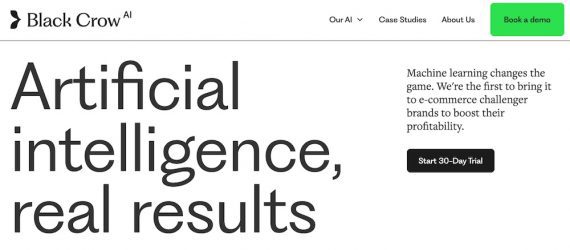The key to ecommerce success is offering compelling, high-demand products and services. Behind those products and services, however, are foundational levers that can make or break a business.
I’ll address four of them in this post.
Technology
The most powerful growth lever in ecommerce and omnichannel retailing is technology. The entire ecommerce industry is based on it.
Technology can automate tasks, such as address verification, fraud detection, Google Ads’ bidding, and platform integrations (with Zapier).
ChatGPT and, more generally, artificial intelligence can streamline product descriptions, content marketing, and search engine optimization, among other strengths. For example, Black Crow, a predictive AI platform, collects first-party data to help ecommerce companies predict visitors’ actions, personalizing their experiences and driving conversions.
The downside of deploying technology is the temptation to chase the newest offerings. A business might buy into software and automation too soon, building out large architectures and tools with no ensuing benefit.

Black Crow, a predictive AI tool, collects first-party data to help ecommerce companies predict visitor actions.
People
When it hires employees or contractors, a business taps into the expertise and productivity of those workers. The leverage people provide is why we form companies.
For ecommerce operations, the people lever can boost throughput. More warehouse pickers and packers could process more orders. More orders processed might lead to fast delivery times, happy customers, and reorders.
The lever is not perfect, however. Too many people can create inefficiencies. For example, an engineering team that writes ecommerce software might be ineffective with, say, 10 developers working on a single feature.
Moreover, a business takes on risk when it hires direct employees. It has a responsibility to them that could impact decisions in the event of an economic downturn or other significant changes in the market.
The same is true for long-term contractual agreements with service providers or agencies.
Content
Content attracts and engages prospects. A well-written product description drives conversions while reducing returns and support requests. A compelling email series entices repeat shoppers. And a blog or social media post can connect with thousands of potential buyers.
Take Rolex, for example. “World of Rolex” is a section on the company’s site to promotes the lifestyle of a Rolex customer. It is the sort of content that could encourage an undecided shopper to make a purchase.
Content is also a lever to fuel multiple marketing campaigns and boost SEO. But content is not a replacement for good products and good business fundamentals.

Rolex uses content as a lever, communicating its brand values and products.
Money
Think about money as a tool. Money buys advertising and inventory. It can purchase technology, hire staff, and even acquire competitors.
Money can help an online retailer create its own private-label products, achieving better margins.
In short, money opens up growth opportunities. But used poorly, money can hurt a business. Over-investing in inventory could lead to negative margins. Buying a high-end ecommerce platform over a lesser option might compound expenses with no tangible gain.




